Physical Address
304 North Cardinal St.
Dorchester Center, MA 02124
The multiple steps by which liver replacement became the treatment of choice for several liver and biliary diseases were summarized in 2002. , The basic operation was developed in dogs during the years 1958 through 1960 and first attempted clinically in 1963 under azathioprine-prednisone immunosuppression. The first humans to have prolonged survival were reported in 1969. However, it was not until the availability of cyclosporine in the 1980s that orthotopic liver transplantation (OLT) became accepted worldwide as effective therapy. The results improved again with the advent of tacrolimus in the 1990s.
Factors other than immunosuppression have contributed to the success of liver replacement, including improved patient selection and pretransplantation management, noninvasive diagnostic techniques, new antibiotics, and advances in anesthetic and perioperative critical care. However, perfection of the donor and recipient operations was the crucial factor on which all else ultimately depended.
The operative report from the world’s first human liver transplant is included, for the sake of historic preservation ( Fig. 125.1 ). The operation took place in Denver, Colorado, in 1963 in a child with biliary atresia (see Chapter 40 ). It is apparent from the operative description that many great strides have been made in the intervening years; at the same time, it is equally apparent that in some respects, not much has changed. It should be remembered when reading this historic document that central venous access catheters and rapid infusion devices had not yet come into use.
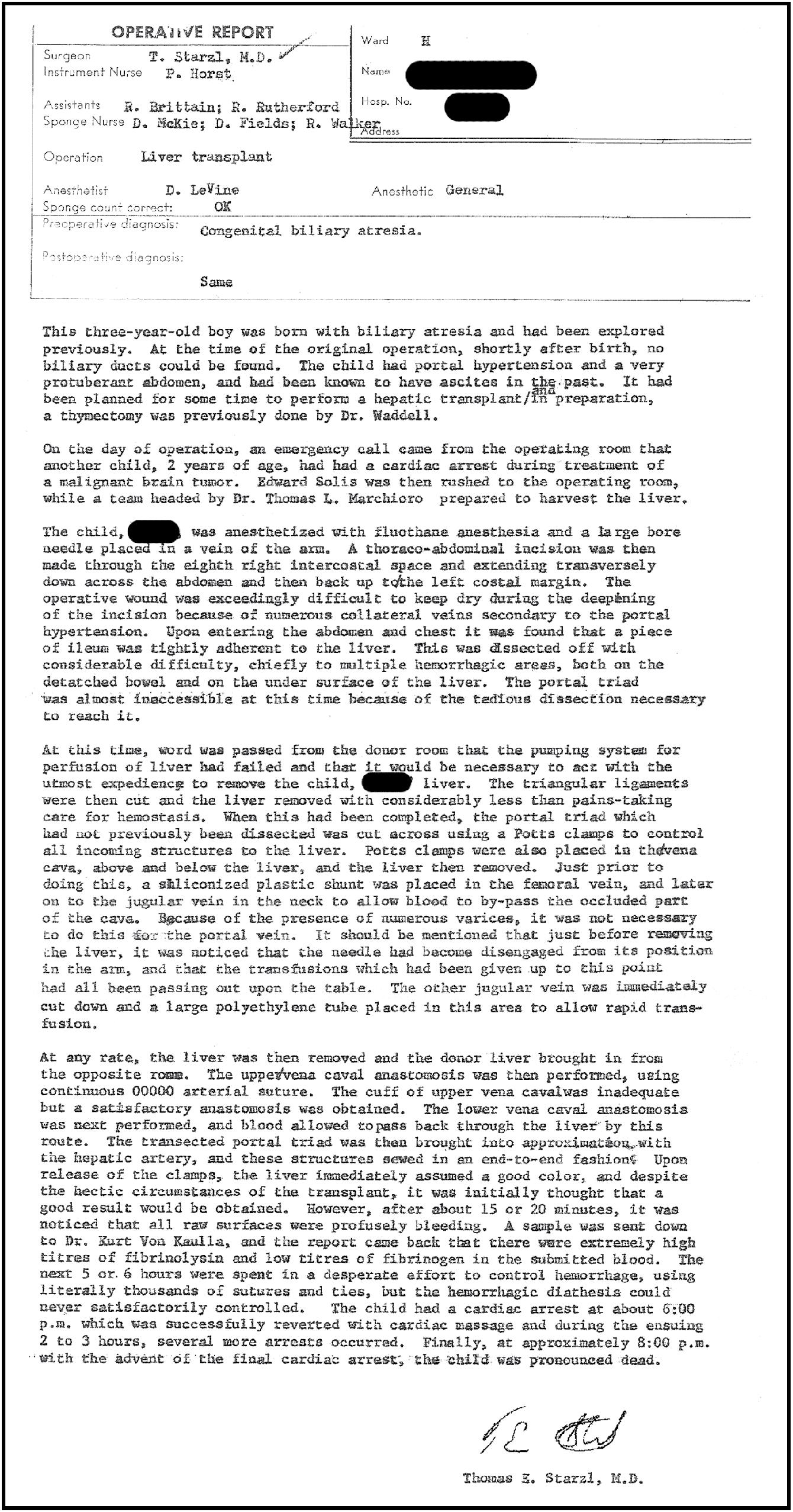
The use of multiple organs from a single deceased donor became practical with the development of standard procurement methods in the early 1980s. Subsequently, the University of Wisconsin (UW) and histidine-tryptophan-ketoglutarate (HTK) preservation solutions made storage of hepatic allografts relatively safe for 12 to 18 hours. The availability of this much time has allowed widespread sharing of livers while permitting an accurate assessment of the allograft by histologic and metabolic criteria.
In the standard procurement technique, a midline incision is made from the suprasternal notch to the pubis to expose the abdominal and thoracic organs of potential interest ( Fig. 125.2 ). After verification that the liver has a normal consistency and color, the left triangular and coronary ligaments are incised, allowing the left lobe to be retracted anteriorly and to the right. This retraction exposes the upper part of the gastrohepatic ligament, which contains the left gastric artery (LGA) and the arterial supply to the liver. If an anomalous left hepatic arterial branch originates from the LGA ( Fig. 125.3 ), it must be preserved in continuity with the main LGA (see Fig. 125.3 , inset ). When present, this anomalous left hepatic arterial branch is almost always present just posterior to the vagus nerve branch as it courses from the lesser curvature of the stomach through the gastrohepatic ligament to the liver.
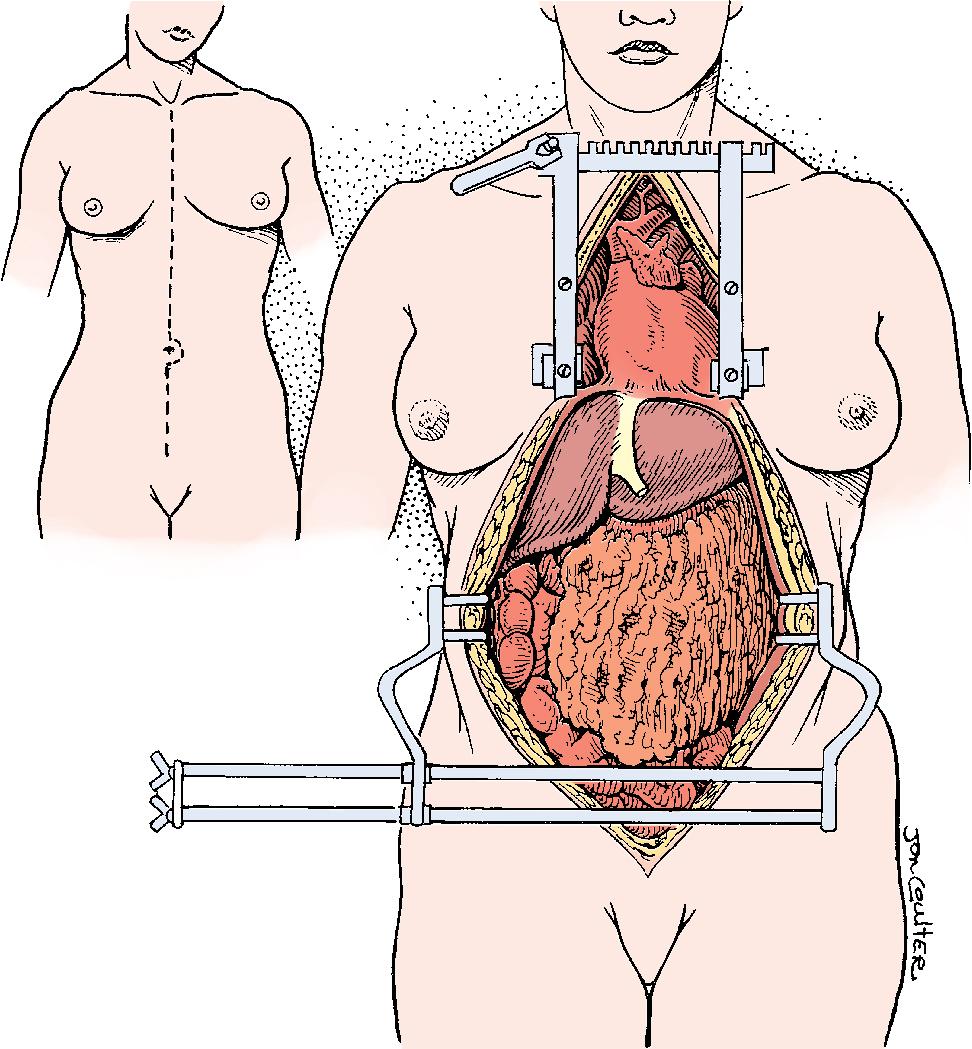
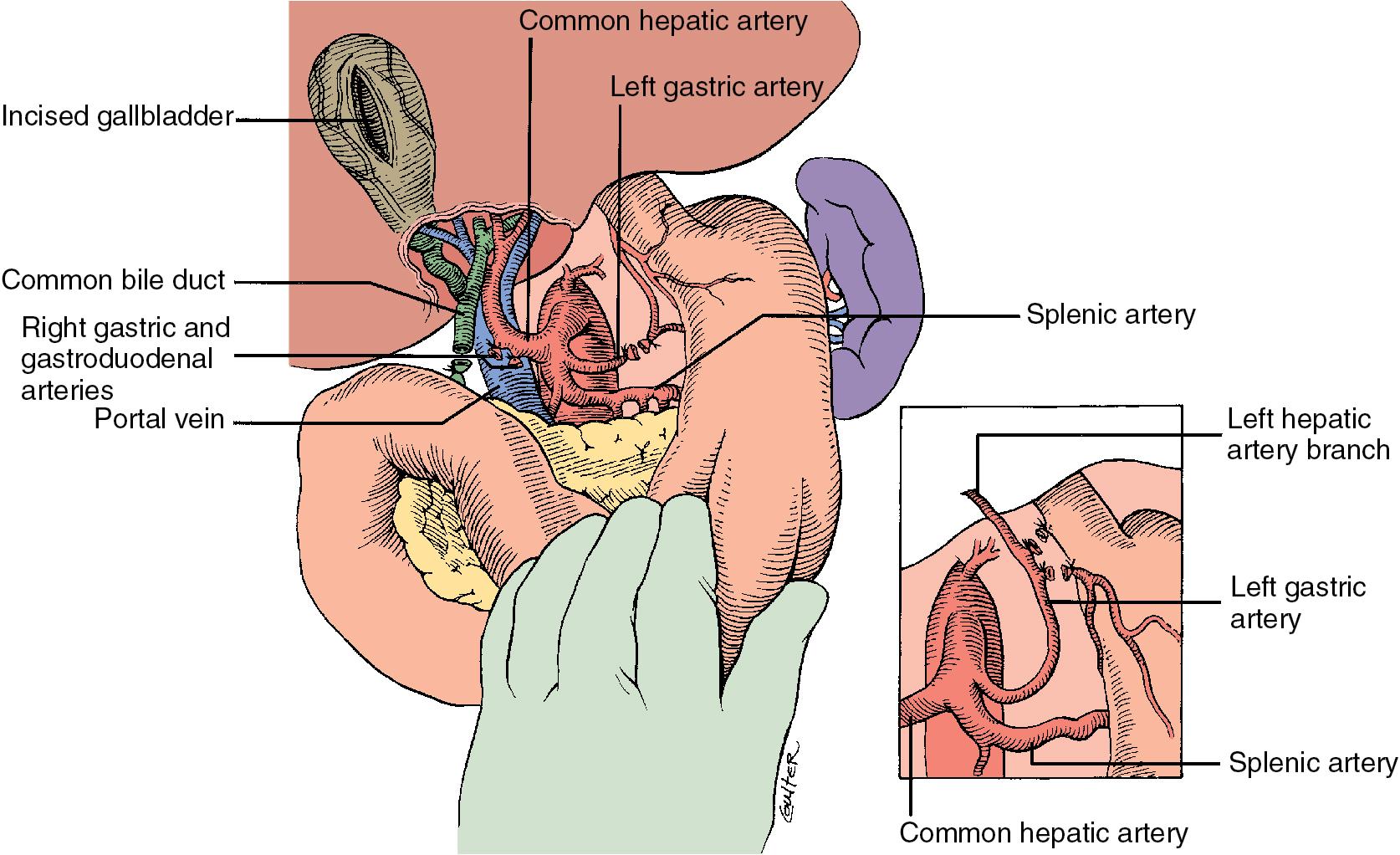
The right colon is mobilized by division of its peritoneal attachments and continues across the retroperitoneum inferiorly; the large and small bowel are then reflected superiorly and toward the left upper quadrant. Kocherization of the duodenum is performed, allowing exposure of the distal aorta and inferior vena cava (IVC). The dissection continues superiorly on the anterior surface of the aorta to the left renal vein. The superior mesenteric artery (SMA) is found immediately superior and anterior to the vein. If simultaneous pancreas retrieval is planned, the SMA is encircled with a vessel loop that can be used to stop the infusion of the perfusate to avoid hyperperfusion of the pancreas. The ligament of Treitz is identified and serves as a landmark to identify the inferior mesenteric vein (IMV), which can easily be dissected from the mesocolon in preparation for aortic cannulation.
The largest branch of the celiac axis is usually the common hepatic artery (see Chapter 2 ). The right gastric artery (which is small and often difficult to identify or absent) and gastroduodenal artery are ligated and divided (see Fig. 125.3 ). After ligation of the left gastric, right gastric, and gastroduodenal arteries, the subsequent dissection of the common bile duct (CBD) and portal vein (PV) is rendered relatively bloodless. The CBD is transected near the duodenum, and the gallbladder is incised and irrigated with saline, which avoids autolysis of the extrahepatic and intrahepatic bile duct epithelium during storage. The PV is now dissected inferiorly to the confluence of the splenic and superior mesenteric veins ( Fig. 125.4 ).
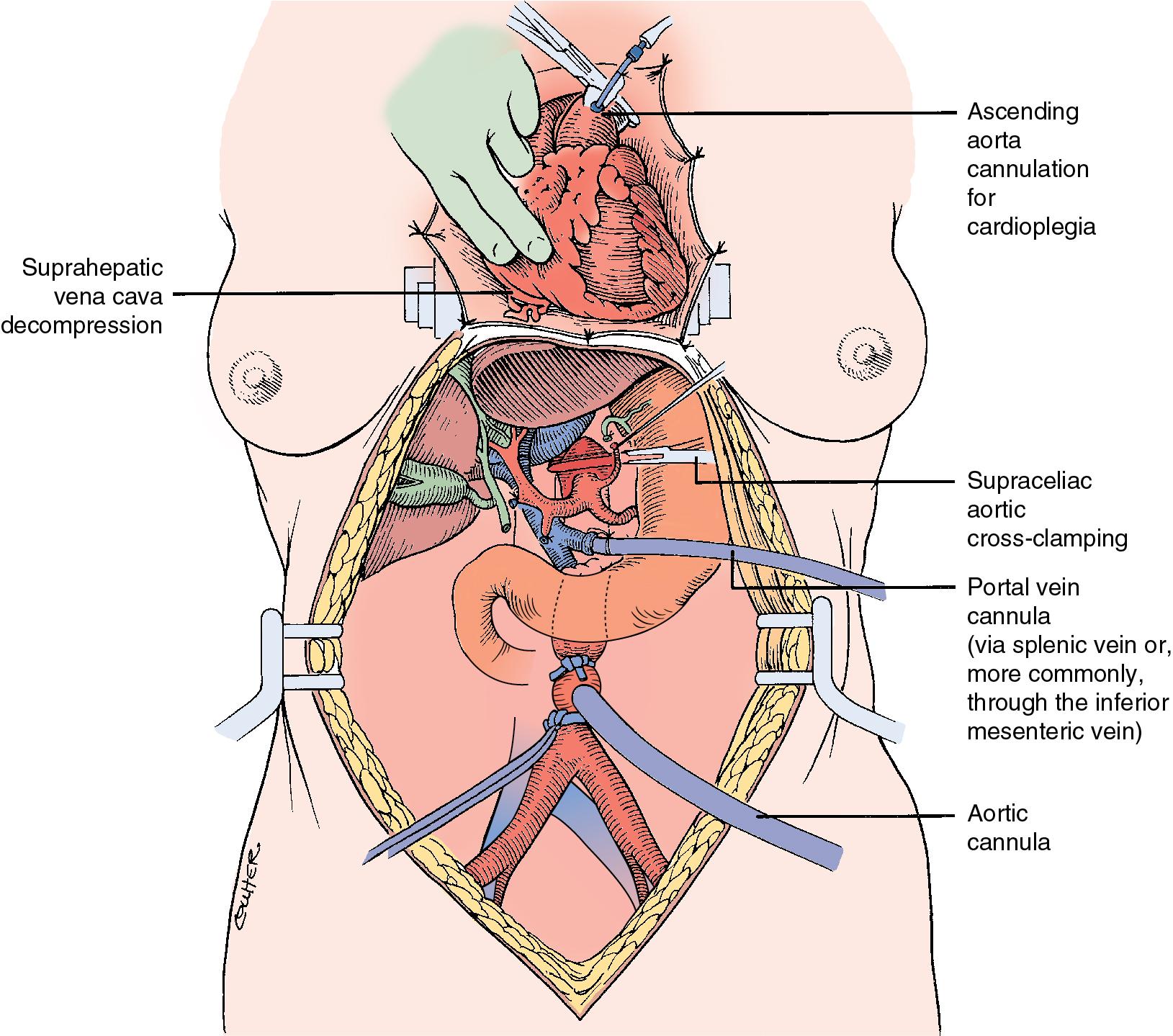
After completing the hilar dissection, the aorta is encircled superiorly, where it passes through the diaphragm and inferiorly just proximal to its distal bifurcation. After total-body heparinization with 300 IU/kg, cannulae for infusion are placed into the IMV and distal aorta (see Fig. 125.4 ). When all procurement teams are ready, the aorta is cross-clamped at the diaphragm or in the chest by the abdominal surgeon (see Fig. 125.4 ) while the thoracic surgical team clamps the ascending aorta. Moderately rapid infusion of cold preservation solution is started into the portal circulation and aortic cannula. Congestion of the various organs is prevented by an incision in the suprahepatic IVC at the level of the right atrium, which allows the blood and perfusate to drain into the pericardium or right chest (see Fig. 125.4 ). The abdominal cavity is filled with ice slush while the preservation solution perfuses the abdominal organs.
In adults, the liver is usually perfused with 2 L of HTK or UW solution through the IMV (or rarely through the splenic vein if the IMV is too difficult to cannulate); either 8 L of HTK or 3 L of UW solution are infused through the aorta (smaller volumes for children). Alternatively, 8 L of HTK or 3 L of UW solution can be infused solely through the aorta. (The perfusion can also be done solely through the aorta if the portal venous system cannot be cannulated.) Once the liver has been removed from the abdominal cavity, the PV is flushed in an expedited manner with 2 L of HTK or 1 L of UW solution or until the effluent is clear. When the liver becomes cold and blanched and the heart and lungs have been removed, the hepatectomy is completed. The remaining dissection must be performed expeditiously but methodically. If the celiac axis is to be retained with the allograft, a proximal segment of its splenic arterial branch should also be conserved for potential reconstruction of an anomalous hepatic artery (see later in this chapter).
The most common hepatic artery anomaly is an aberrant right hepatic artery (RHA) originating from the SMA, usually within its first 2 cm, traveling posterior to the PV ( Fig. 125.5 ) (see Chapter 2 ). If the pancreas is to be discarded, the anomalous retroportal artery can be kept in continuity with the SMA and excised from the aorta (see Fig. 125.5 , inset ); its origin can be incorporated into a Carrel patch shared with the origin of the celiac axis. If the pancreas is being procured, the accessory RHA can be divided to the right of the duodenum and reimplanted into the gastroduodenal or splenic artery stump on the back table.
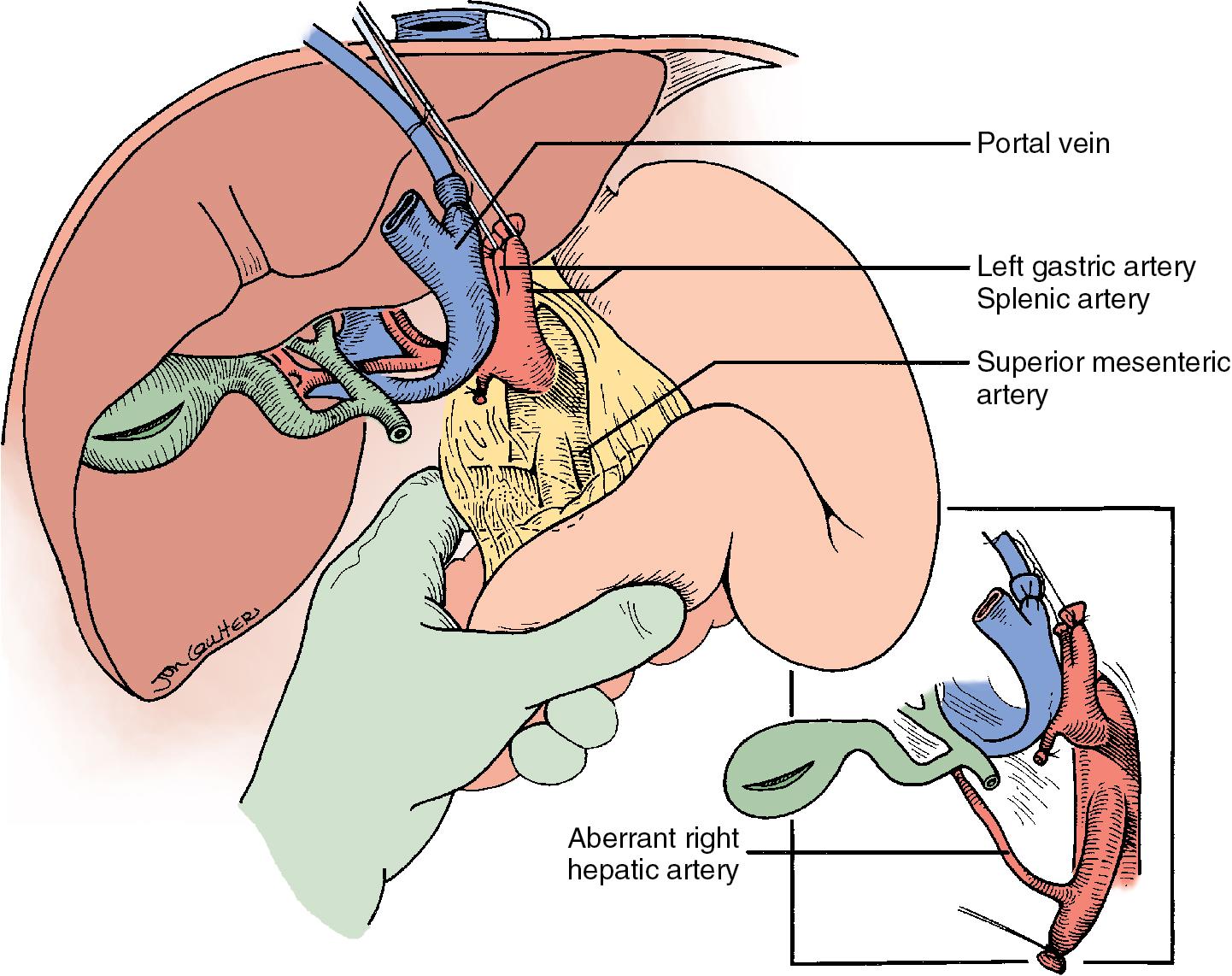
The liver now remains attached primarily by the vena cava above and below the liver. The vena cava below the liver is transected above the entry of the renal veins ( Fig. 125.6 ). The vena cava above the liver is transected with a surrounding rim of diaphragm that will be excised on the back table. The retrohepatic IVC is dissected free from the attached tissues, including ligation of the right adrenal vein and posterior lumbar tributaries. (These steps can also be done on the back table.) Once the cross-clamp is applied, the retrohepatic IVC can be retrieved in continuity with the liver and surrounding tissue, including the superior half of the right adrenal gland. The liberated liver is immediately placed in a bag filled with chilled preservation solution and surrounded by an outer second bag, all packed in ice ( Fig. 125.7 ); the CBD is flushed with HTK or UW preservation solution before packaging the liver.
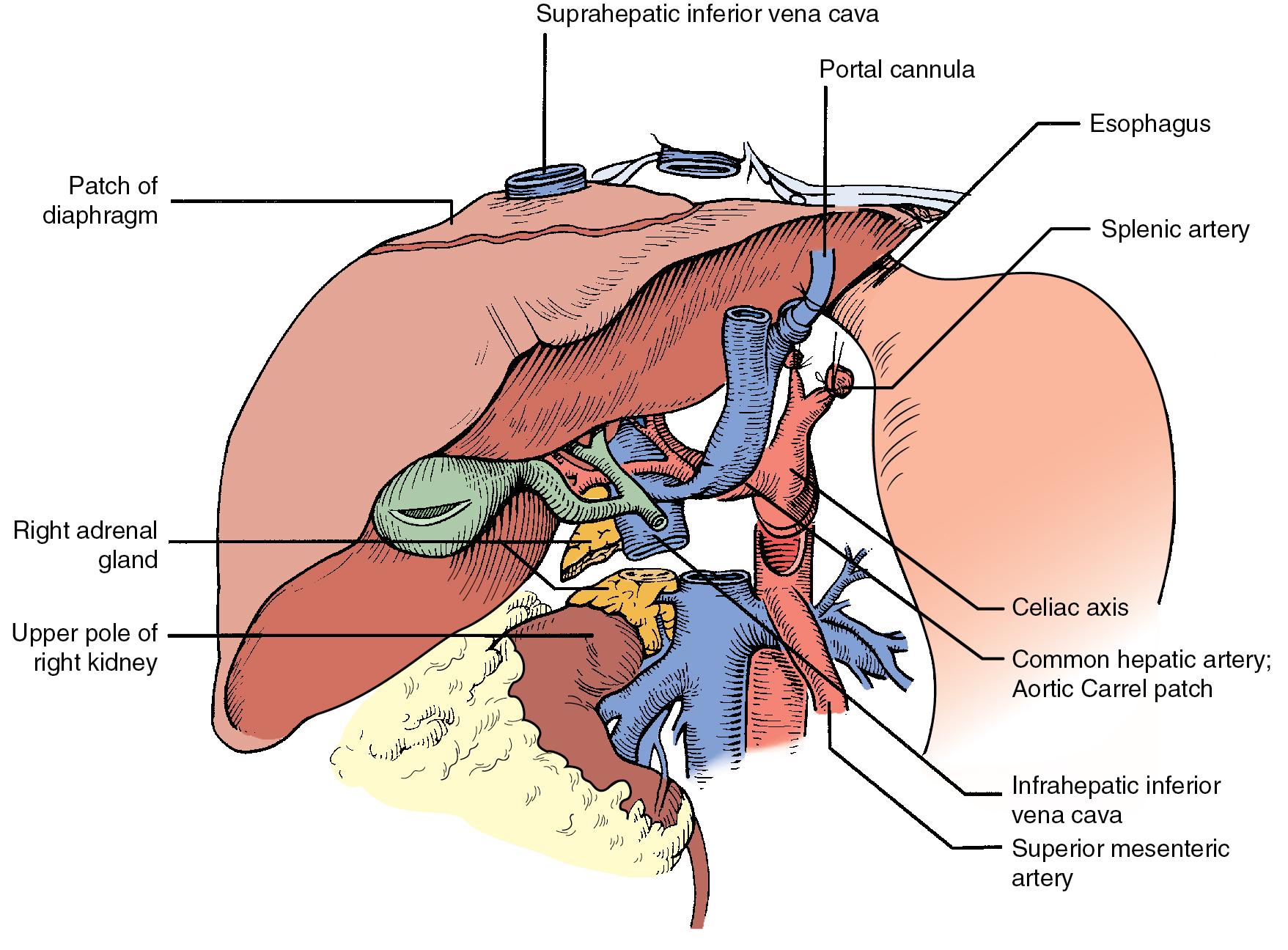
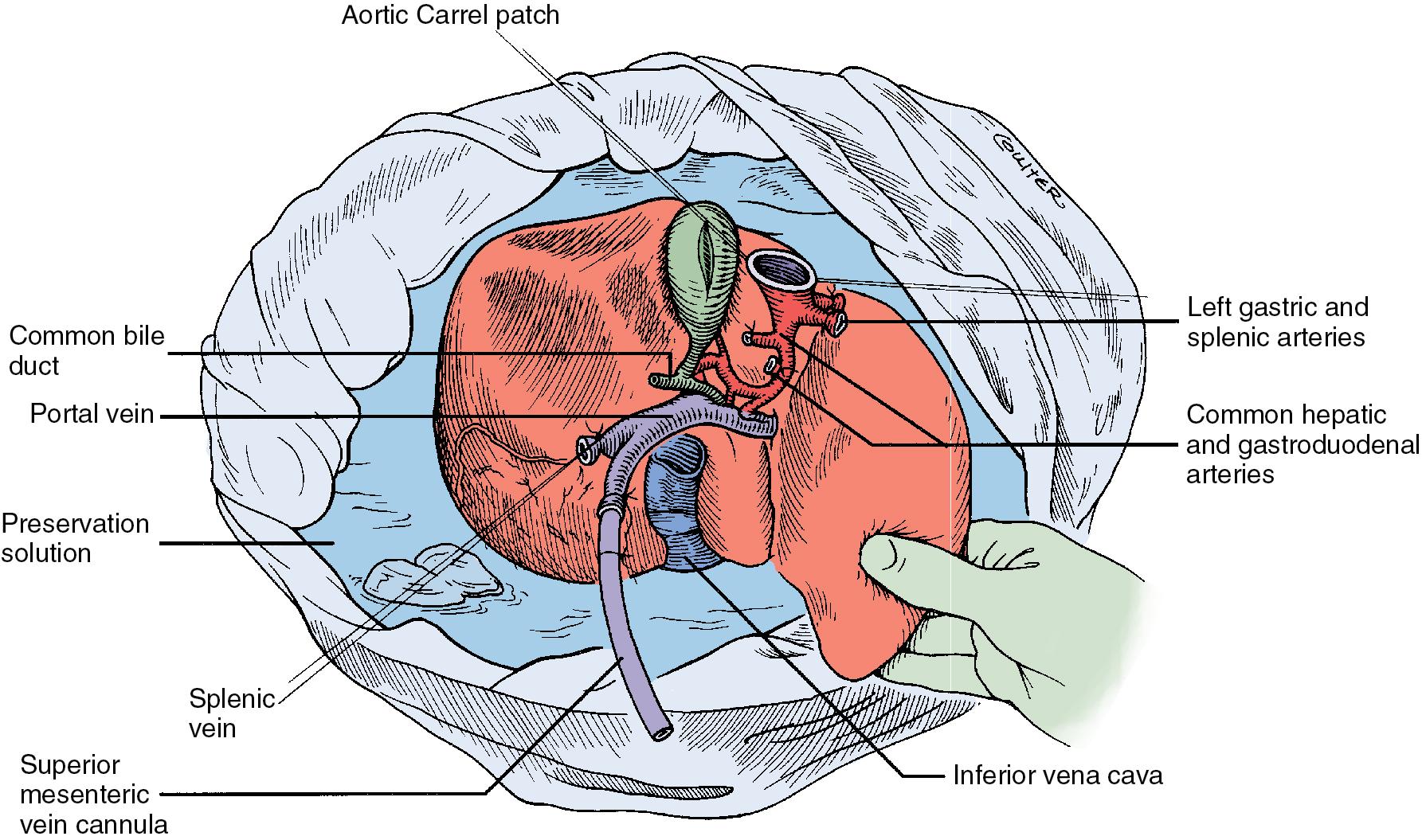
Use of the standard technique in stable donors has allowed the training of relatively inexperienced surgeons in the performance of a donor hepatectomy. When the technique is mastered, faster methods can be applied electively or, if required, by urgent clinical circumstances. With the rapid techniques, little or no preliminary dissection is done except for encirclement of the supraceliac aorta and cannulation of the IMV (or, rarely, the splenic vein) and terminal aorta ( Fig. 125.8 ). If the heart and/or lungs are to be removed, the cardiothoracic surgeon proceeds as if other organs are not to be harvested but gives warning before the circulation is stopped.
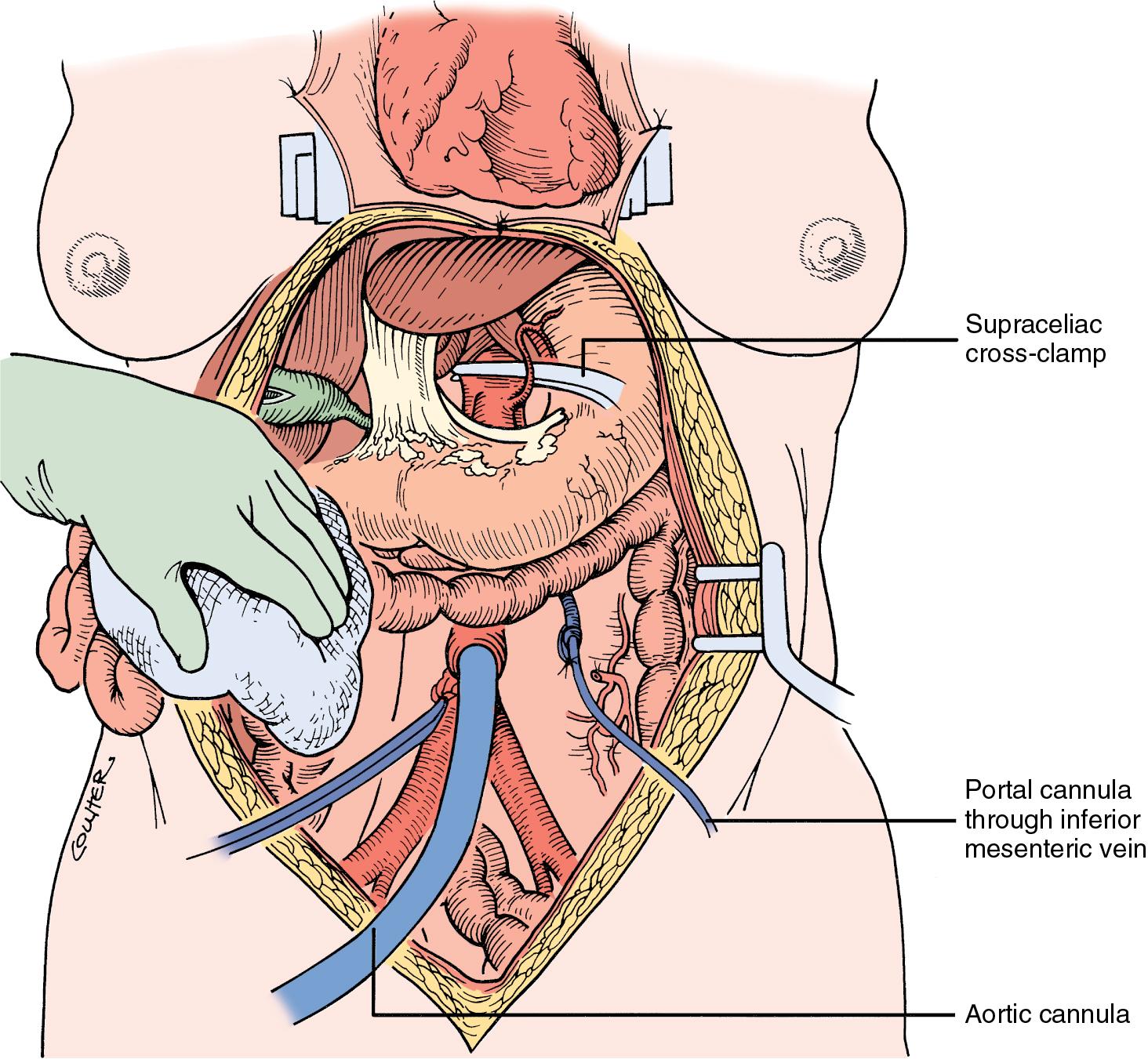
At the moment the cardiothoracic surgeon is ready to cross-clamp the thoracic aorta, the supradiaphragmatic IVC should be vented. The abdominal aorta is cross-clamped above or just below the diaphragm, and an infusion of cold preservation solution is infused through the IMV and distal aorta (see Fig. 125.8 ). The amount of preservation fluid with the rapid technique is approximately the same as that used for the standard method (see earlier discussion). Again, as an alternative, the liver can be flushed only through the aorta and then flushed through the PV ex situ as previously described. When the liver becomes cold, the infusions are slowed. In the now bloodless field, the main vessels of the celiac axis can be quickly dissected, and the hilar dissection can be completed in a matter of minutes.
The PV is cleaned inferiorly to the junction of the splenic and superior mesenteric veins, and these two tributaries are divided. As in the standard method, the surgeon must promptly exclude the possibility of a retroportal RHA originating from the SMA, as well as other arterial vascular anomalies (see Chapter 2 ). The hepatectomy is then completed. The kidneys, which are excised only after the liver has been removed from the field, are kept cold throughout by the placement of ice slush into the abdomen and by the slow, continuous intraaortic infusion of the preservation solution. By performing all dissections in the bloodless field, it is possible to remove multiple organs (heart, liver, pancreas, and both kidneys) in approximately one-half hour. Procurement of the intestine adds only a few additional minutes.
In an arrested donor or donation after cardiac death (DCD), an even quicker procedure can be used to procure satisfactory organs (see Chapter 109 ). This method can also be applied in countries that do not have “brain death” laws or under special legal or religious circumstances. Here, cooling requires urgent cannulation and cold-fluid infusion into the distal aorta; with practice, cannulation of the IMV can also be accomplished for a simultaneous in situ portal flush ( Fig. 125.9 A). Sternum splitting, thoracic aortic cross-clamping, and venting the IVC for venous decompression are performed (see Fig. 125.9 B); quick clamping of the root of the mesentery should be performed to direct the perfusate to the celiac trunk and renal systems if the pancreas has not been retrieved. Cannulation and perfusion of the portal venous system can be deferred until after the various organs are at least partially cooled intraarterially (see Fig. 125.9 C). The various dissections are done in the same way as with the standard and rapid techniques. Effective application of this method requires an extremely high level of skill. If the donor hospital’s DCD protocol does not allow for intravenous heparinization before procurement, the heparin can be added to the initial bags of preservation solution.
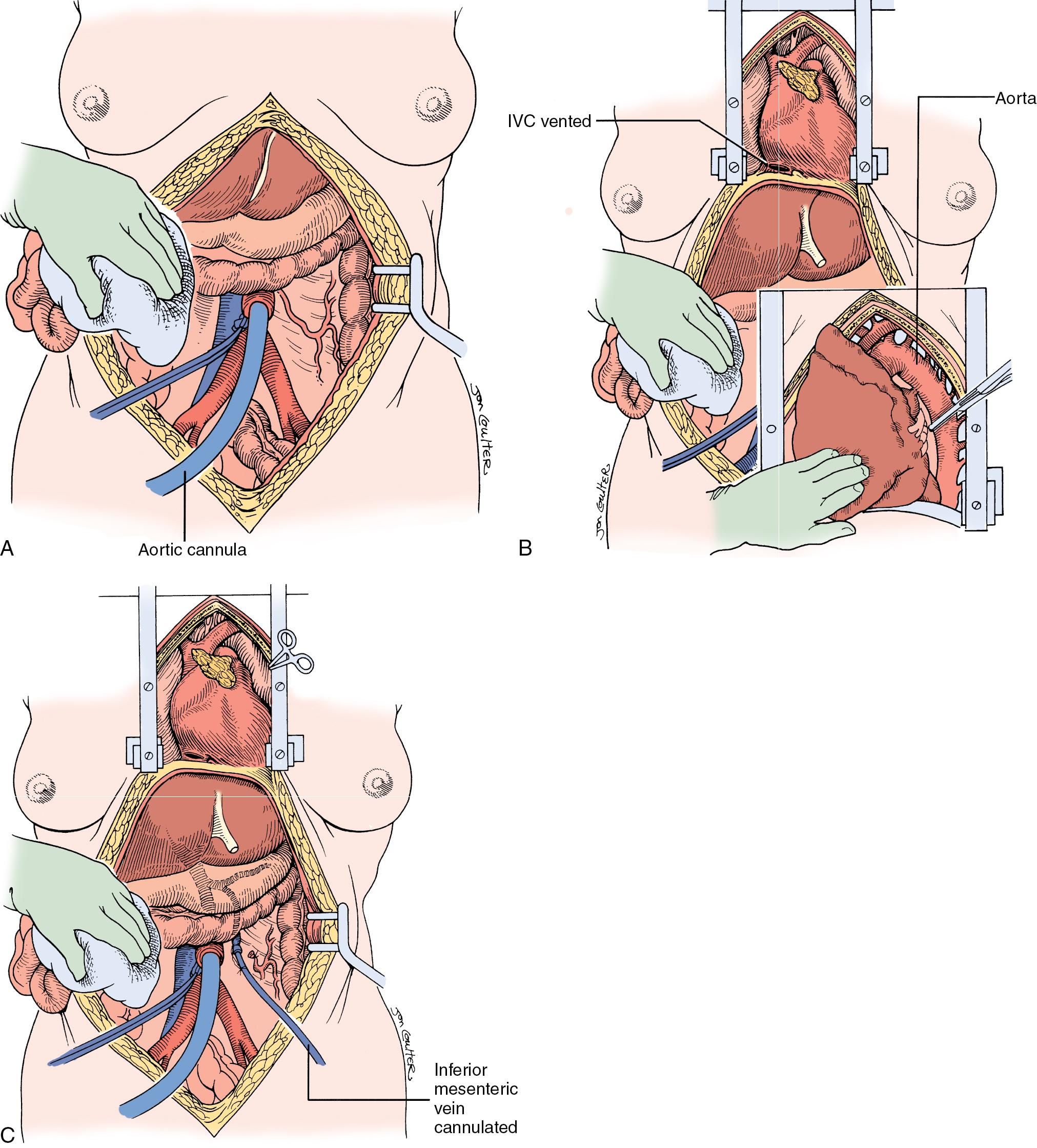
No matter which procurement method has been used, further preparation of the liver is performed on the back table before delivering it to the recipient surgeon. The liver should be kept cold by submerging it in a basin containing ice-cold preservation solution surrounded by an outer bag containing sterile ice slush (see Fig. 125.7 ). Back-table preparation includes the following:
Dissection and removal of extraneous tissue (diaphragm, adrenal gland, lymph node, pancreatic, peripancreatic, and ganglionic tissue)
Preparation of cuffs of the suprahepatic and infrahepatic vena cava, cleaning of the PV and hepatic artery, and inspection of the bile duct
Verification of secure ligatures on small retrohepatic caval, PV, and hepatic arterial branches
Ensuring the continuity and integrity of all major structures that must be anastomosed to the companion recipient structures
Failure to have the liver completely ready for implantation can result in irreversible damage or make it impossible to complete the recipient operation. Several methods of back-table vascular reconstruction have been designed to repair technical accidents or to accommodate aberrant vessels or congenital anomalies. A common reason for back-table reconstruction is the presence of an anomalous RHA originating from the SMA ( Fig. 125.10 ).
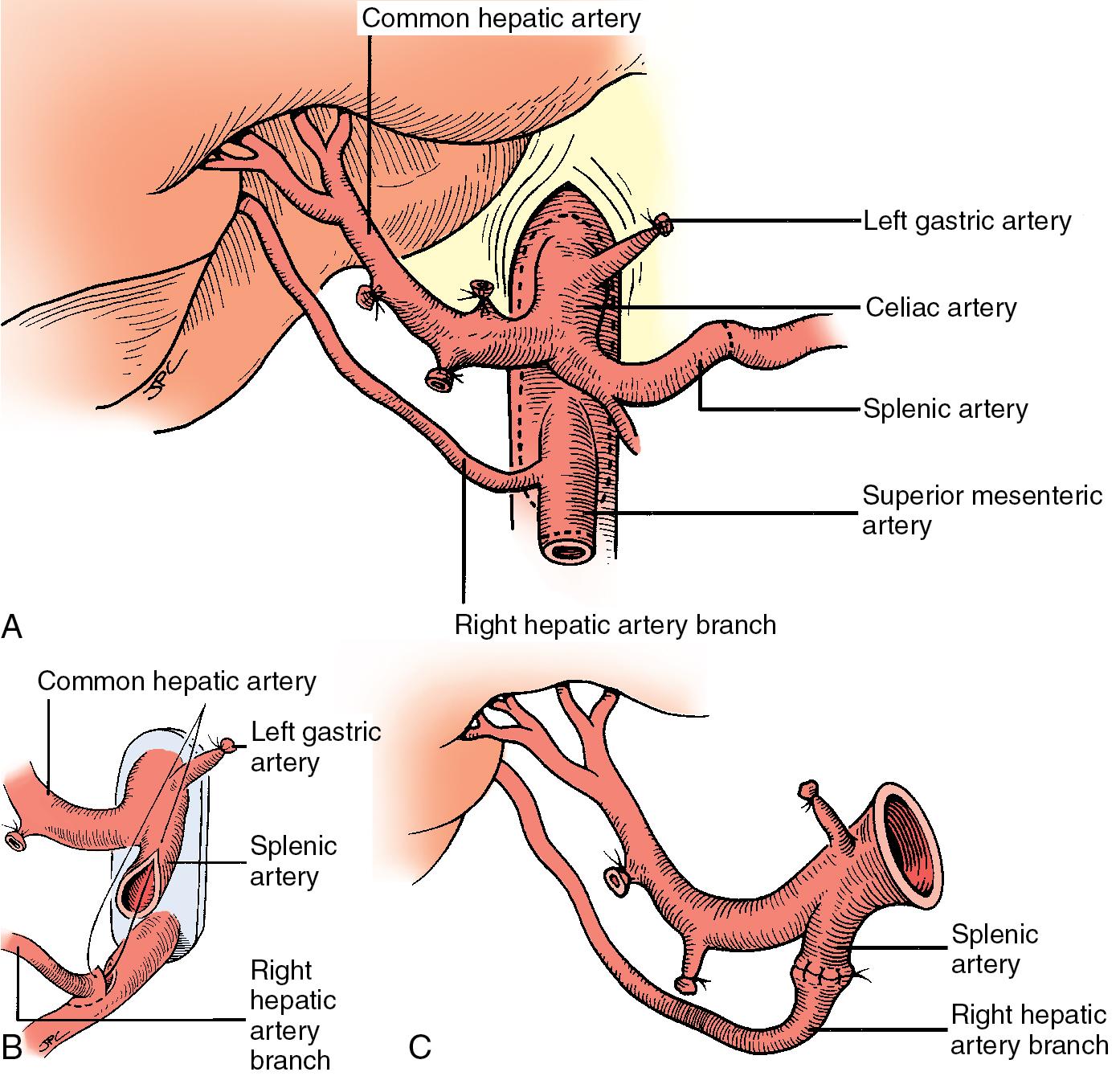
The pancreas and intestine can be retrieved independently or together with the liver. Before starting the procurement, the operation should be discussed among all surgeons involved. Considerations include organ priority, type and amount of preservation solution to be used, presence of aberrant hepatic arteries, length of PV, and a decision about which organ retains the celiac axis or SMA (see Chapter 126 ).
An important step in any deceased-donor operation is the removal and storage of long segments of the donor iliac arteries and veins, as well as other arteries and veins. These vessels can be used as vascular conduits to reconstruct the blood supply of the individual organs. With increased experience, it is rare to see any of the abdominal visceral organs discarded for purely technical reasons.
The recipient procedure has three phases, which may be long and physically demanding. The first phase involves removal of the native liver, almost always in the face of portal hypertension (see Chapters 74 and 79 ). The second phase is the anhepatic phase, which involves the vascular anastomoses and implantation of the donor liver allograft. The third phase requires the achievement of hemostasis and biliary reconstruction.
The exact location of the incision may be influenced by previous right upper quadrant and abdominal surgery. A bilateral subcostal incision is most often used, extending on the right to just beyond the midaxillary line and on the left to the lateral edge of the rectus muscle, with an upper midline extension and excision of the xiphoid process ( Fig. 125.11 ). If exposure of the distal aorta is required for reconstruction of the hepatic arterial supply, the subcostal components can be extended (thoracic extensions are rarely needed). The upper midline extension is usually unnecessary in pediatric patients. Massive hepatomegaly, extensive prior abdominal surgery, or other factors may mandate the selection of a more extensive incision. In patients who require concomitant splenectomy or interruption of a prior splenorenal shunt, the incision may need to be extended to the left subcostal region.
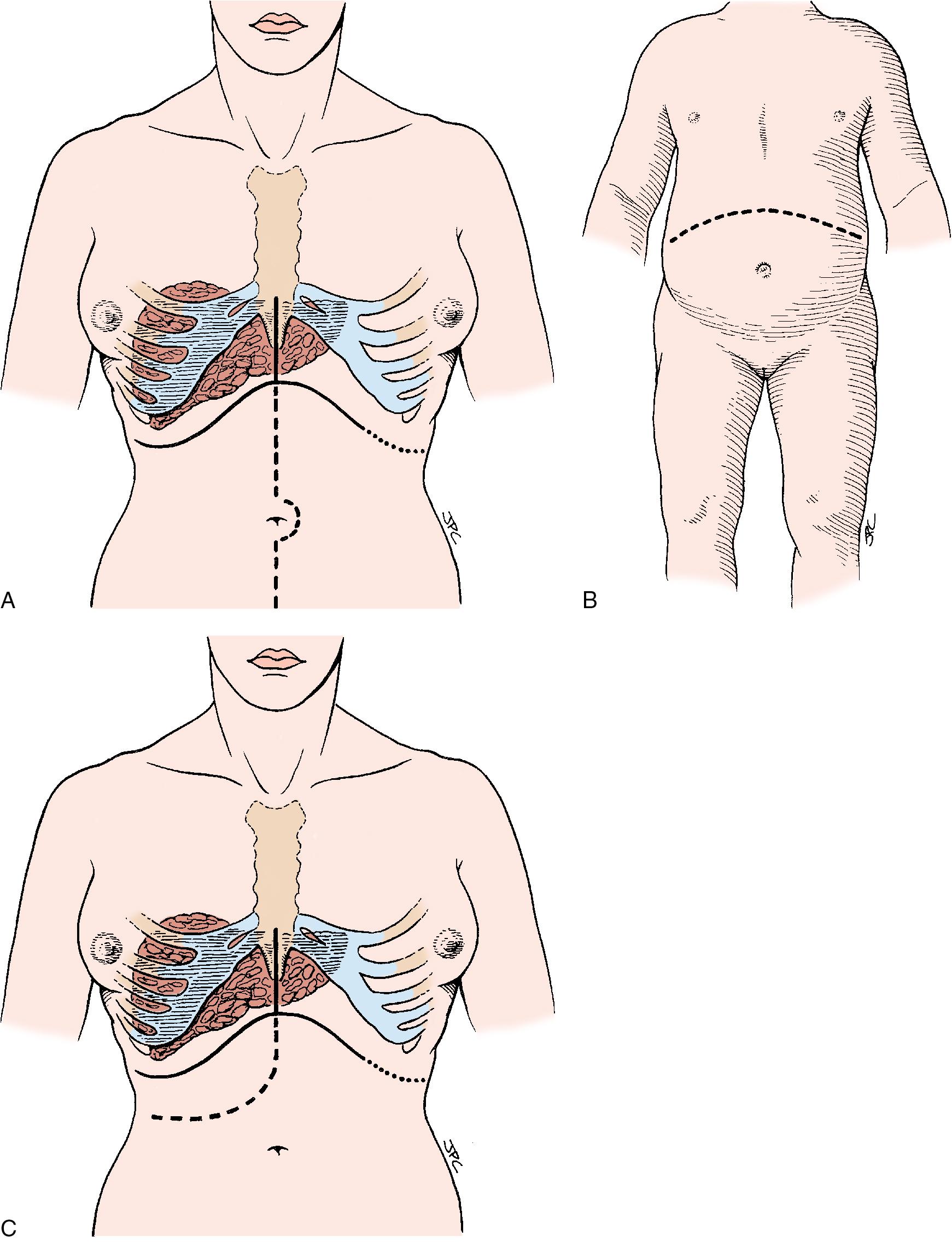
Become a Clinical Tree membership for Full access and enjoy Unlimited articles
If you are a member. Log in here